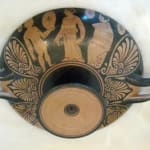Faliscan Red-Figure Kylix, 380 BCE - 360 CE
Terracotta
10.5
PF.5519
The Greek colonies of southern Italy (known in antiquity as Magna Grecia) were marked by their initial allegiance to the ceramic styles of the Attic mainland. However, over the years,...
The Greek colonies of southern Italy (known in antiquity as Magna Grecia) were marked by their initial allegiance to the ceramic styles of the Attic mainland. However, over the years, native traditions and innovations heavily influenced the works of Magna Grecian potters. Unorthodox forms and painting-styles were seamlessly merged with the standard Greek style, creating distinctive works of art unique to the Hellenistic world. This gorgeous red-figure stamnos comes from the Faliscan region of central Italy, to the northwest of Rome. Neighbors of the Etruscans, today the Faliscan people are best remembered for their language, which was believed to be very similar to Latin. So similar, in fact, that scholars believed the language was displaced by Latin in the years after Falerii, the Faliscan capital, was conquered by the Romans in 241 B.C. Faliscan pottery, as revealed by this red-figured stamnos, was highly influenced by the vessels created by their Greek neighbors to the south.
This exquisite vessel is commonly known as a “kylix”. A “kylix” is a drinking cup with a horizontal handle on either side and used for wine. Its name seems to be applied to the cup in any shape. The kylix usually has a frieze picture on its outside and another pictur on its inside which is called a tondo. This bowl with continuous profile from the lip to the body and handles has a shape like a wishbone. This cup was produced in the middle of the fourth century and very few examples have survived.
The tondo with a seated woman to the left, a mantle around her waist with a tongue border and a star pattern throughout, a bandolier across her nude torso, a rayed diadem in her curly locks, coiled bracelets on her fore-arms, her left arm raised, her right arm at her side, facing a nude youth with a mantle across his shoulders, leaning forward on a staff, a laurel wreath in his hair, grapes and a fillet in the field, framed by a border on meander with saltire and checkered squares; both sides of the exterior with a draped woman between a draped and nude youth, palmette complexes below the handles.
This exquisite vessel is commonly known as a “kylix”. A “kylix” is a drinking cup with a horizontal handle on either side and used for wine. Its name seems to be applied to the cup in any shape. The kylix usually has a frieze picture on its outside and another pictur on its inside which is called a tondo. This bowl with continuous profile from the lip to the body and handles has a shape like a wishbone. This cup was produced in the middle of the fourth century and very few examples have survived.
The tondo with a seated woman to the left, a mantle around her waist with a tongue border and a star pattern throughout, a bandolier across her nude torso, a rayed diadem in her curly locks, coiled bracelets on her fore-arms, her left arm raised, her right arm at her side, facing a nude youth with a mantle across his shoulders, leaning forward on a staff, a laurel wreath in his hair, grapes and a fillet in the field, framed by a border on meander with saltire and checkered squares; both sides of the exterior with a draped woman between a draped and nude youth, palmette complexes below the handles.



